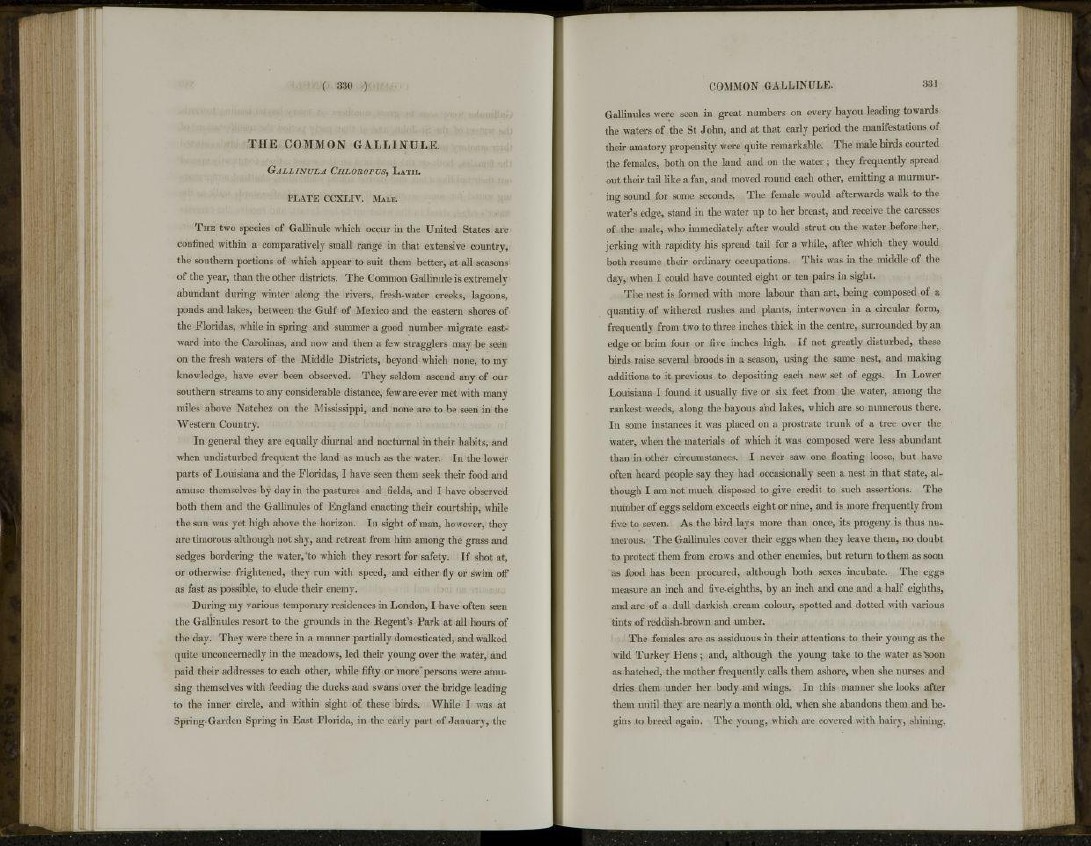
( 330 )
T H E C O M M O N G A L L I N U L E.
GALLINULA CHLOROPUS, LATH.
P L A T E C C X L I V . MALE.
THE two species of Gallinule which occur in the United States are
confined within a comparatively small range in that extensive country,
the southern portions of which appear to suit them better, at all seasons
of the year, than the other districts. The Common Gallinule is extremely
abundant during winter along the rivers, fresh-water creeks, lagoons,
ponds and lakes, between the Gulf of Mexico and the eastern shores of
the Floridas, while in spring and summer a good number migrate eastward
into the Carolinas, and now and then a few stragglers may be seen
on the fresh waters of the Middle Districts, beyond which none, to my
knowledge, have ever been observed. They seldom ascend any of our
southern streams to any considerable distance, few are ever met with many
miles above Natchez on the Mississippi, and none are to be seen in the
Western Country.
In general they are equally diurnal and nocturnal in their habits, and
when undisturbed frequent the land as much as the water. In the lower
parts of Louisiana and the Floridas, I have seen them seek their food and
amuse themselves by day in the pastures and fields, and I have observed
both them and the Gallinules of England enacting their courtship, while
the sun was yet high above the horizon. In sight of man, however, they
are timorous although not shy, and retreat from him among the grass and
sedges bordering the water, "to which they resort for safety. If shot at,
or otherwise frightened, they run with speed, and either fly or swim off
as fast as possible, to elude their enemy.
During my various temporary residences in London, I have often seen
the Gallinules resort to the grounds in the Regent's Park at all hours of
the day. They were there in a manner partially domesticated, and walked
quite unconcernedly in the meadows, led their young over the water, and
paid their addresses to each other, while fifty or more"persons were amusing
themselves with feeding the ducks and swans over the bridge leading
to the inner circle, and within sight of these birds. While I was at
Spring-Garden Spring in East Florida, in the early part of January, the
COMMON GALLINULE. 331
Gallinules were seen in great numbers on every bayou leading towards
the waters of the St John, and at that early period the manifestations of
their amatory propensity were quite remarkable. The male birds courted
the females, both on the land and on the water; they frequently spread
out their tail like a fan, and moved round each other, emitting a murmuring
sound for some seconds. The female would afterwards walk to the
water's edge, stand in the water up to her breast, and receive the caresses
of the male, who immediately after would strut on the water before her,
jerking with rapidity his spread tail for a while, after which they would
both resume their ordinary occupations. This was in the middle of the
day, when I could have counted eight or ten pairs in sight.
The nest is formed with more labour than art, being composed of a
quantity of withered rushes and plants, interwoven in a circular form,
frequently from two to three inches thick in the centre, surrounded by an
edge or brim four or five inches high. If not greatly disturbed, these
birds raise several broods in a season, using the same nest, and making
additions to it previous to depositing each new set of eggs. In Lower
Louisiana I found it usually five or six feet from the water, among the
rankest weeds, along the bayous and lakes, which are so numerous there.
In some instances it was placed on a prostrate trunk of a tree over the
water, when the materials of which it was composed were less abundant
than in other circumstances. I never saw one floating loose, but have
often heard people say they had occasionally seen a nest in that state, although
I am not much disposed to give credit to such assertions. The
number of eggs seldom exceeds eight or nine, and is more frequently from
five to seven. As the bird lays more than once, its progeny is thus numerous.
The Gallinules cover their eggs when they leave them, no doubt
to protect them from crows and other enemies, but return to them as soon
as food has been procured, although both sexes incubate. The eggs
measure an inch and five-eighths, by an inch and one and a half eighths,
and are of a dull darkish cream colour, spotted and dotted with various
tints of reddish-brown and umber.
The females are as assiduous in their attentions to their young as the
wild Turkey Hens ; and, although the young take to the water as *soon
as hatched, the mother frequently calls them ashore, when she nurses and
dries them under her body and wings. In this manner she looks after
them until they are nearly a month old, when she abandons them and begins
to breed again. The young, which are covered with hairy, shining,